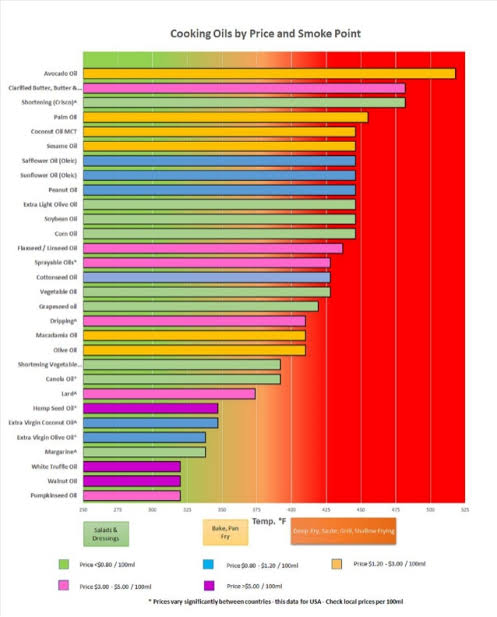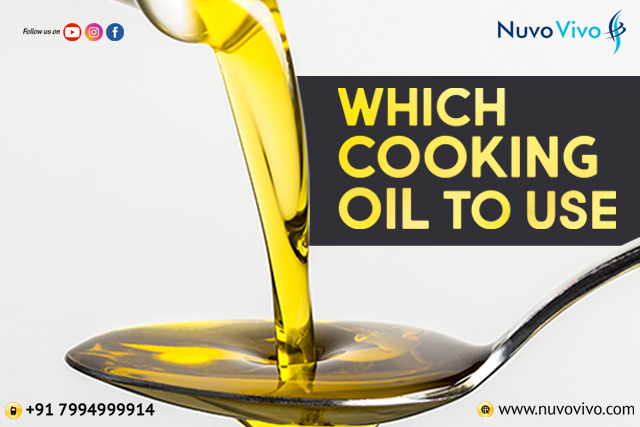This is indeed a million-dollar question. We are not going to list down different oils and mention which is healthy; because that is not how it works! Healthy or unhealthy depends on many factors, mainly – how was the oil produced, what kind of cooking is done, how much heat are you going to subject the oil to, etc!
As you all know, oil is nothing but fat & 1 gm of fat has 9 calories (much more than 4 cal per gram for both protein & carbs). We can divide oils based on the kind of fatty acid they primarily contain – Saturated, Mono-Unsaturated & Poly-Unsaturated fat.
Saturated fat has strong single bonds between carbon atoms (C-C) and is hence less solid in the room temperature and more resistant to heat. The smoke point or the temperature at which the saturated oil disintegrates by generating harmful free-radicals is usually high for saturated oil. Eg – Coconut oil, Palm Oil, Butter, Ghee, Animal fat, etc
Monounsaturated fat has one double bond between carbon atoms (C=C), while polyunsaturated fatty acid has two or more double bonds. Such fatty acid molecules are hence less stable and are liquidy at room temperature. Olive oil, canola, avocado oil, etc are Mono-unsaturated oils. Fish oil, sunflower oil, etc are Polyunsaturated. The smoke point of both saturated & unsaturated fatty acids are comparatively lower
Points to remember while chosing an oil
- Indian style of cooking often involves stir-frying, which is frying food at high temperatures. If you are heating food at such high temperature, it is advised to use the more stable Saturated oils (Butter, ghee, coconut oil) as they have the least amount of oxidative stress during heating
- However, it is advised to not have too much of saturated fats. The medical world is still debating if saturated fat increases cholesterol & heart diseases. As a general practice, it is best to limit the saturated fat calories to less than 10% of the total calorie intake
- Animal fat is mostly 50% saturated fat and the remaining 50% monounsaturated. However, too much of animal fat can be harmful for the human body, as animals accumulate and store toxins (Eg – Persistent organic pollutants) in their fat cells. However, free-grazing or grass-fed animal meat tends to have much lesser toxins in their fat cells
- The unsaturated fats, especially poly-unsaturated, are good for health. If the food does not require frying at high temperatures, then Unsaturated fats are more heart-friendly. Unsaturated oils such as olive oil, avocado oil, etc are hence better for salad dressing, etc
- However, if the food requires to be fried, or baked at high temperatures, unsaturated oil can be highly dangerous. This is because these oils can turn into trans fat at such high temperatures. Transfat is highly dangerous and can cause an increase in LDL (bad cholesterol) and a series of Coronary Heart Diseases (CHD). As a thumb rule, do not use any vegetable oil if it requires stir fry at a deep temperature. Transfat is also known as hydrogenated vegetable oil
- Apart from the saturated vs unsaturated distinction, fatty acids can be differentiated based on the number of carbon atoms in it. The short & medium-chain fatty acids (with less than 6 or 12 carbon atoms respectively) are usually liquid at normal temperatures, with a low smoking point. The long-chain fatty acids are solid and are more heat resistant
Any oil is always a mixture of different types of fatty acids – short, medium, long-chained, saturated, mono-unsaturated, poly-unsaturated, etc. The properties of an oil, thus dependents on the chain length and degree of saturation of the main type of fatty acid it contains. Since oil is rich in calories and is highly complicated with many potential health impacts, its best to limit the usage of oil to as minimum as possible
Reach us to start your online fitness regime with us – Click here to reach us
The Smoke point of oils


